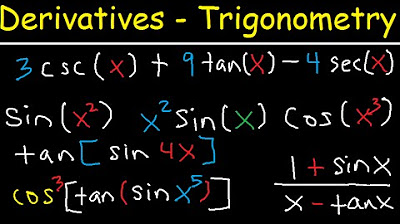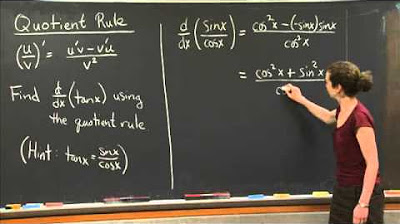Derivatives of Trigonometric Functions
TLDRThis transcript delves into the derivatives of trigonometric functions, highlighting the six fundamental ones. It explains the derivatives of sine and cosine, and then introduces a pattern for the derivatives of tangent, cotangent, secant, and cosecant. The video provides examples of applying these derivatives to expressions, demonstrating the process of differentiation. The emphasis on recognizing cofunctions and their derivatives, particularly those starting with 'c' which have a negative sign, is a key takeaway. The examples solidify the understanding of trigonometric derivatives and their relationships.
Takeaways
- 📚 The derivative of sine x is cosine x.
- 📈 The derivative of cosine x is negative sine x.
- 🔄 For tan and cot, their derivatives are related to secant and cosecant squared respectively.
- 📊 The derivative of tangent (tan x) is secant squared (sec^2 x).
- 📉 The derivative of cotangent (cot x) is negative cosecant squared (-csc^2 x).
- 🔢 The derivative of secant (sec x) is sec x multiplied by tangent (tan x).
- 📐 The derivative of cosecant (csc x) is negative cosecant x times cotangent (-csc x * cot x).
- 🧩 Cofunctions starting with 'c' (like cotangent and cosecant) have negative derivatives.
- 🤝 Similarities exist between the derivatives of tan and cot, as well as secant and cosecant.
- 📝 To find the derivative of a trigonometric expression, distribute the derivative of each term.
- 🌟 Knowing the derivatives of sine, tangent, and secant allows one to determine the derivatives of the other functions.
Q & A
What is the derivative of sine x?
-The derivative of sine x is cosine x.
What is the derivative of cosine x?
-The derivative of cosine x is negative sine x.
What pattern can be observed in the derivatives of trigonometric functions that start with a 'c'?
-The derivatives of trigonometric functions that start with a 'c', particularly cofunctions like cotangent, have a negative sign.
How are the derivatives of tan and cotan related?
-The derivative of tangent is secant squared, and the derivative of cotangent is negative cosecant squared. They are related through their respective cofunctions and the signs of their derivatives.
What is the derivative of tangent x when multiplied by a constant?
-When a constant is multiplied by tangent x, the derivative is the constant times the derivative of tangent x. So, the derivative of 'n' times tangent x is 'n' times secant squared.
What is the derivative of the expression 5 sine x - 4 tangent x?
-The derivative of the expression 5 sine x - 4 tangent x is 5 cosine x - 4 secant squared x.
How do you find the derivative of 8 secant x - 5 cosine x?
-The derivative of 8 secant x - 5 cosine x is 8 secant x tangent x + 5 sine x, based on the derivatives of secant and cosine x.
What is the derivative of cotangent x?
-The derivative of cotangent x is negative cosecant squared x, due to the pattern observed with cofunctions starting with 'c'.
What is the derivative of the expression 2 cotangent x - 7 cosecant x?
-The derivative of the expression 2 cotangent x - 7 cosecant x is negative 2 cosecant squared x + 7 cosecant x cotangent x.
How can you simplify the derivative of the expression 2 cotangent x - 7 cosecant x?
-You can factor out the greatest common factor, which is cosecant x, to simplify the derivative to -2 cosecant squared x + 7 cosecant x cotangent x.
Why is it important to know the derivatives of sine, tangent, and secant?
-Knowing the derivatives of sine, tangent, and secant is crucial because they form the basis for understanding the derivatives of other trigonometric functions, as seen in the patterns and relationships between them.
Outlines
📚 Derivatives of Trigonometric Functions
This paragraph introduces the derivatives of trigonometric functions, highlighting the six key derivatives that are essential to understand. It begins with the derivatives of sine (cosine x) and cosine (negative sine x), and then proceeds to discuss the derivatives of tangent (secant squared) and cotangent (cofunction of tangent, which is cosecant squared with a negative sign). The paragraph emphasizes the pattern and similarity between the derivatives of tan and cotan, as well as secant and cosecant. It also provides a method for determining the derivatives of expressions involving trigonometric functions through examples, demonstrating how to apply the derivatives of sine, tangent, and secant to find the derivatives of more complex expressions.
📝 Summary of Trigonometric Derivatives
In this paragraph, the speaker summarizes the key points made in the previous discussion on trigonometric function derivatives. It reiterates the importance of recognizing the patterns and relationships between the derivatives of trigonometric functions, particularly the negative sign associated with cofunctions starting with 'c'. The speaker leaves the final answer of the examples provided in the previous paragraph as a reference for further study, ensuring that the audience has a clear understanding of how to derive the derivatives of trigonometric functions.
Mindmap
Keywords
💡Derivatives
💡Trigonometric Functions
💡Sine Function
💡Cosine Function
💡Tangent Function
💡Secant Function
💡Cotangent Function
💡Cosecant Function
💡Derivative of Expressions
💡Patterns in Derivatives
💡Examples and Practice
Highlights
Derivative of sine x is cosine x.
Derivative of cosine x is negative sine x.
Derivative of tangent is secant squared.
Derivative of cotangent is negative cosecant squared.
Derivative of secant is secant x tangent x.
Derivative of cosecant x is negative cosecant x cotangent x.
Cofunctions starting with 'c' have negative derivatives.
Similarities between derivatives of tan and cotan, secant and cosecant.
Derivative of an expression, five sine x minus four tangent x, is 5 cosine x minus 4 secant squared x.
Derivative of eight secant x minus five cosine x is 8 secant x tangent x plus 5 sine x.
Derivative of two cotangent x minus seven cosecant x is negative 2 cosecant squared x plus 7 cosecant x cotangent x.
Knowing the derivatives of sine, tangent, and secant helps in figuring out the other three derivatives.
The derivative of cotangent is negative cosecant squared, following the pattern of cofunctions with a 'c'.
The derivative of cosecant is negative cosecant cotangent, maintaining the negative sign pattern for cofunctions.
Understanding the derivatives of trigonometric functions is essential for solving calculus problems involving them.
The process of finding derivatives involves recognizing patterns and applying the rules of differentiation.
Transcripts
Browse More Related Video

Derivatives of Trigonometric Functions

Derivatives of Trigonometric Functions - Product Rule Quotient & Chain Rule - Calculus Tutorial

Derivatives of Trig Functions (Sin, Cos, Tan) in Calculus - [1-4]

Calculus 1 Lecture 2.5: Finding Derivatives of Trigonometric Functions

Derivative of Sine and Cosine Functions | Calculus

Quotient Rule | MIT 18.01SC Single Variable Calculus, Fall 2010
5.0 / 5 (0 votes)
Thanks for rating: